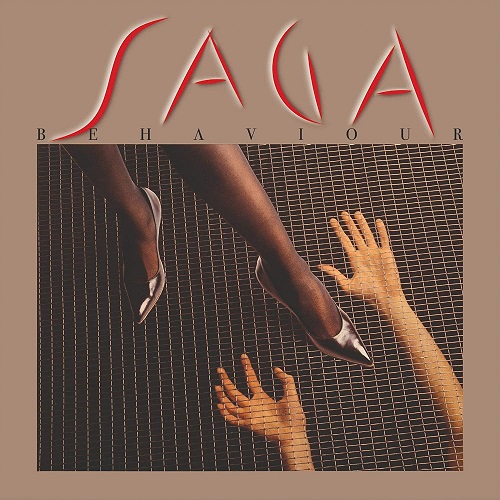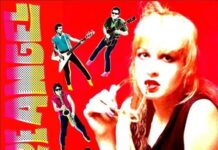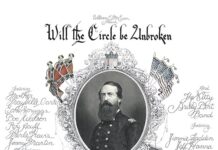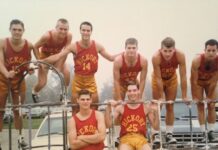On their sixth album in seven years, Canadian powerhouse Saga reached an artistic crossroads.
After scoring major American success with their seminal Top 40, 1981 track “On the Loose,” and accompanying Worlds Apart and Heads Or Tales albums, the quintet shifted course — updating their look, sound, and style to better acclimate an MTV generation’s worth of fans. Their music would become sleeker, shifting from anthemic stadium staples to (almost) more atmospheric adult contemporary.
Behaviour, released in 1985, would be the last for a period to feature the core band nexus of frontman Michael Sadler, guitarist Ian Crichton, bassist Jim Crichton, keyboardist Jim Gilmour, and drummer Steve Negus.
It would also go on to be, perhaps, their most underrated album overall.
“From the beginning, we’ve always had creative control. The record company never got involved in all that. With the big MTV thing, we were all over MTV with all these videos,” Ian Crichton told me recently. “Things were going so well and then we went and changed. Even got haircuts — we used to have long hair. I don’t think that was a great move for the band. [But] there was some pretty cool stuff on the record.”
Though their popularity extends farther overseas (in Europe especially per their roster of live albums), Saga remains one of the world’s more underrated bands (“One of my favorite bands ever,” says Lennie Petze, then senior vice president of Epic and Portrait A&R). They were never a pyrotechnic, flashy type group but instead one that exuded major confidence. When you heard them sing “On the Loose,” you wanted to be right alongside them as they put their minds “on idle” and “let the others take ‘em for a while.” I’ve listened to their song “Don’t Be Late (Chapter 2)” literally hundreds of times and it always sounds as stellar as the first time I heard it 20 years earlier.
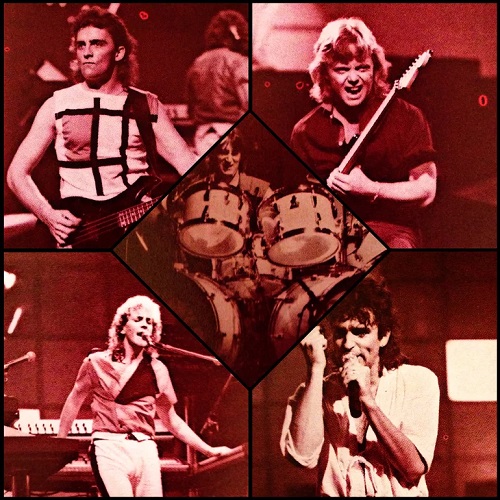
Now I want to make clear that I’m not saying that Behaviour is a bad album. Far from it! Where the band had sowed its hard rock/proggy oats on prior releases, they transfer their unique sound into what fits the aesthetic at the time. Think a top-notch Survivor album (finger point at Vital Signs) just with Sadler’s wholly underrated vibrato-rich voice. Really, Saga’s album is no different than efforts from such contemporaries as Yes and Genesis, which each shortened their tracks and went in a more direct commercial path around the same time. Even when trying things a little more simple in nature and writing about more universal themes (i.e., love, relationships, and the like), Saga still finds the perfect balance of progressive sensibilities and digestible album rock.
Yet in shifting course on Behaviour — complete with a producer change, and a changing approach to their songwriting — Saga would enter the next pivotal phase of its collective career, one that knocks the group down to a trio for several years before a triumphant reunion in the early 1990s.
As part of our interview, I asked Crichton about the components that made Behaviour a different creative experience compared to Saga’s prior albums.
“That record took about four or five months in the recording studios to make. Two months in Switzerland at Powerplay Studios, two months at Union Studios in Munich — we did a few weeks in Compass Point, Bahamas,” he said. “Right up to Heads Or Tales, we would go into a rehearsal place and literally jam; have the recorder on; go through all these things; pick out these parts; and eventually make tunes out of them. They were pretty much done by the time we got into the studio. Behaviour was done in the studio. Once we got into the studio for the first five records, it was a matter of adjusting arrangements and lyrics only and things like that. We were pretty much starting from scratch in Behaviour — that was different for us.”
Another key element missing from this album (like its predecessor Heads or Tales) is its lack of “chapter” songs. For eight tracks over the band’s first four albums, we would be enveloped in non-chronological story nuggets detailing the journeys of a bug-like alien with the brain of Einstein. Many of these tracks, including “Will It Be You?,” “No Regrets, and “Too Much To Lose” would go on to be ubiquitous staples of the band’s live shows.
“That created, “What’s this all about?” It’s like Iron Maiden, they had that spooky character [Eddie]. We had the bug that flies. My brother Jim wrote the actual story with the help of Mike Sadler,” Crichton says. “The story was over. It was over.”
The alien’s journey would be resurrected in the late 1990s and early 2000s, with the creation of another eight chapter songs, bringing the total — and, to date, final — tally to 16.
On Behaviour, Saga would also change producers — shifting from Rupert Hine (Chris De Burgh, Rush, Tina Turner) to Peter Walsh.
“It would have been great to do it with Rupert — sorry, Pete Walsh — it would have been perfect, and then doing it back in England, that would have definitely been the way to go,” Crichton said. “We had to move on and keep going. That’s really what changed the sound of the band and all that.”
Where the band’s first two albums are much more spacey and story-fueled in nature, their third, Silent Knight (1980), would bring the group into a new decade. Worlds Apart ultimately puts them on the global map, right as MTV starts taking over the airwaves.
While it may seem obvious that Worlds Apart is a great album (it is!), if you listen to Behaviour, you can best deem it as Saga’s version of 90125. You can’t deny the experimental sounds within it, but you also can’t deny the tried-and-true pop songs created to try to keep the group on the charts worldwide. Instead of coming right out the gate with a hard-hitting track like “How Long” from their eponymous debut album, “It’s Time” from Images at Twilight, or “The Flyer” from Heads or Tales, Behaviour begins with slower, more keyboard heavy “Listen to Your Heart.” While there would be a noticeable amount of moody slower-tempo rockers like “You And The Night,” “What Do I Know,” and “Promises,” the band still makes sure it knows how to rock and rock well on tracks like “Take A Chance,” “Misbehaviour,” and “Here I am.”
“(Behaviour) kind of finished us in the states. The whole persona of the band, the look of the band, the sound of the band, we changed. We fixed something that wasn’t broken,” Crichton says. “The funny thing is CBS didn’t pick up our next option because we only sold 400,000 records in the states. It’s ridiculous to think of that now. Justin Bieber might sell that many right now in this age of digital. It’s funny to think of that, just how times change.”
Though only a small number of the album’s tracks make their modern day set lists, Behaviour is an important record in the group’s discography because it emphasizes that even though changes are made, the band’s original influences and creativity can still be found throughout. They take a chance, and it is a worthwhile one.
“The sound of Saga really comes from the five of us – we’re all different guys. We were into progressive rock. We liked Gentle Giant, Genesis, King Crimson, all of that,” Crichton says. “I think the idea with Saga was not to go total prog though. We wanted to be accessible because a lot of these things have a small market and that sort of thing. So we sort of took those ideas and Saga had its own style and it became prog rock. We were both worlds. Prog was in there and then it goes away for a minute and then it comes back, mixed with Michael Sadler’s vocal and our playing and stuff like that. It just sort of created this sound.”
Behaviour would also ensure the group remained a viable touring presence stateside for a while longer. Per Crichton: “We toured all over the states in the ‘80s. We weren’t headlining but we were opening up for everyone — Jethro Tull, Pat Benatar, Billy Squier. We played all the big venues.”
Upon the group reaching its 40th anniversary in 2018, the shocking announcement came that the end for Saga was imminent. Fortunately, the decision was reversed, and the band still tours to this day (albeit with a couple of newer members). At the height of the global pandemic, they released the more acoustic-based Symmetry album in 2020, featuring reworkings of some of their classic tracks like “Tired World” and “Images.”
“It wasn’t a unanimous decision to pack it in. I said, ‘C’mon guys, let’s keep going here.’ I’ve never retired or really even thought of it,” Crichton told me. “With COVID, I was kind of forced into retirement and if that’s retirement, then nah, I don’t think so. I’m not good at sitting around. Even if I was down in the Caribbean with a nice boat and all that, within a month I’d be bored to death. I like to work, write, play. My work has been an enjoyment my whole life even with the ups and downs. I very much appreciate we’ve come this far and are still playing.”
“Saga will keep going and keep playing shows,” Crichton says, adding that with his brother Jim Gilmour officially retiring from the group, it remains up in the air if new Saga music will complement its 23-album lineup.
As for Crichton, he has been keeping busy with a new side project, the dynamic trio SiX By SiX. The group, which also features Saxon drummer Nigel Glockler and vocalist and multi-instrumentalist Robert Berry, released its eponymous first album this year. Plans to tour behind the album — as well as assemble a follow-up — are forthcoming.
“We’re really happy with this record. I want to get this out there and around,” Crichton says. “We want to keep this thing in the eye. We don’t want it to go stagnant.”
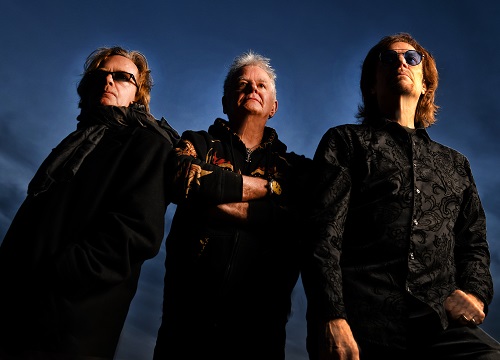
***
Share your feedback and suggestions for future columns with Ira at vinylconfessions84@gmail.com. Ira’s new book, “Hello, Honey, It’s Me”: The Story of Harry Chapin, is available for purchase here.


